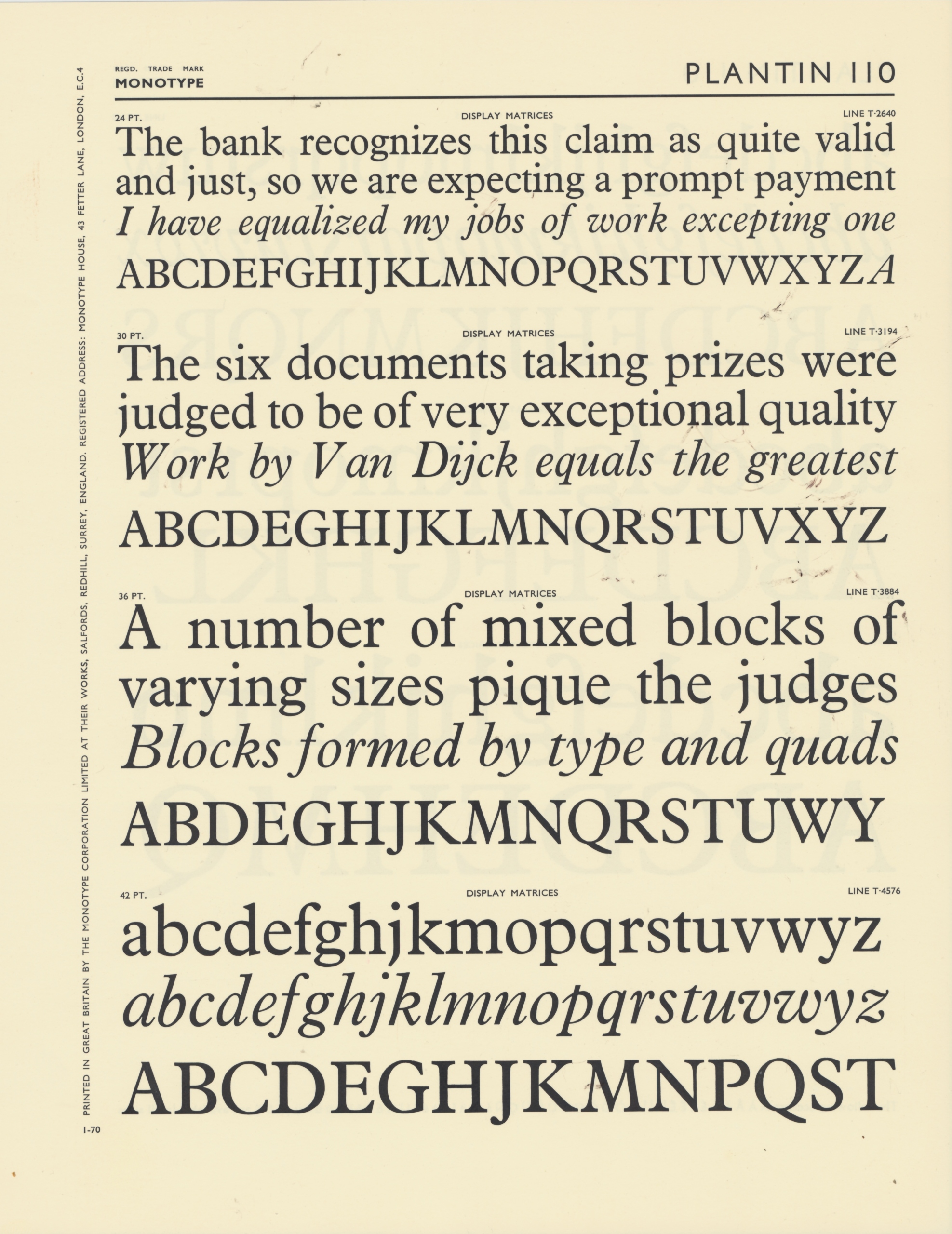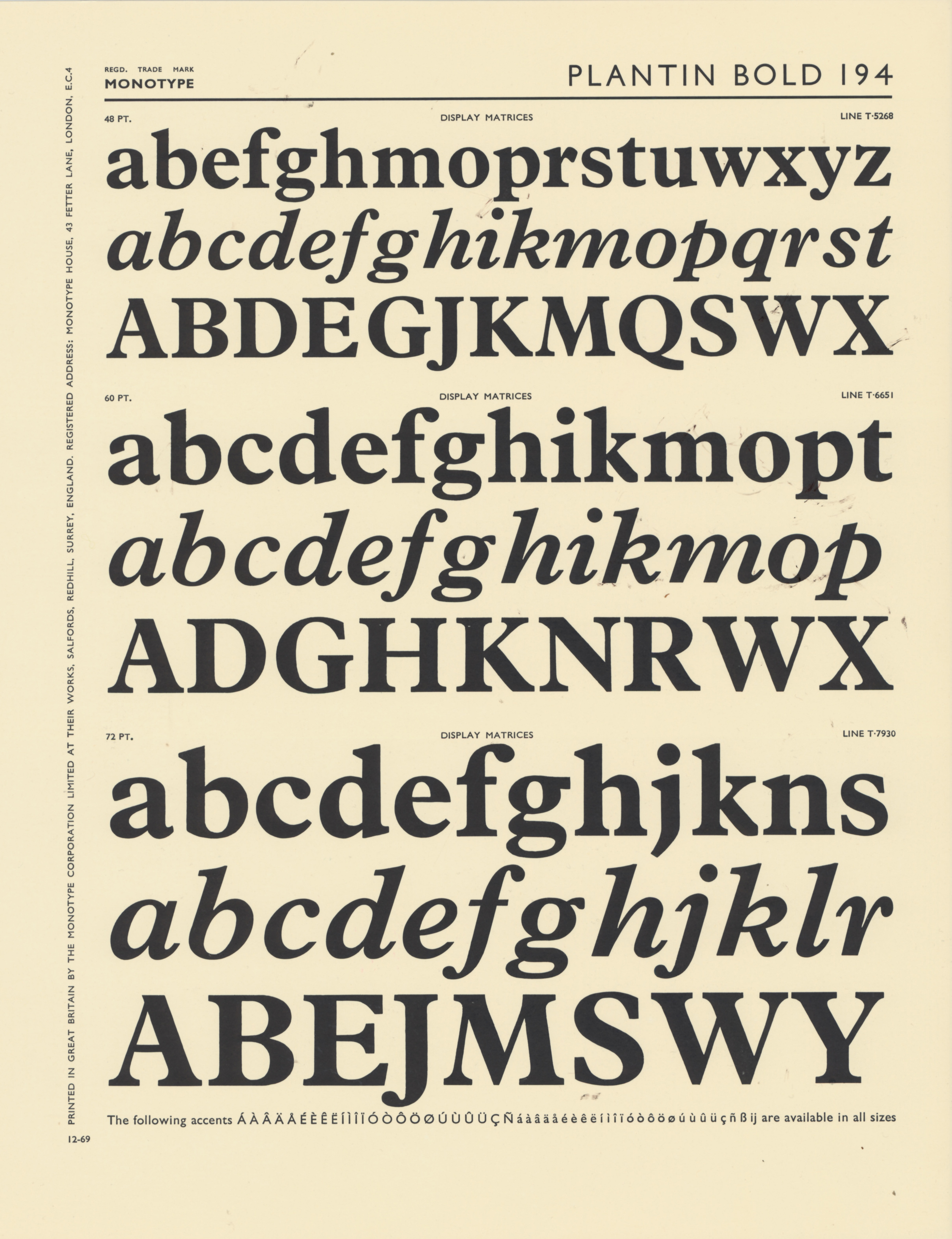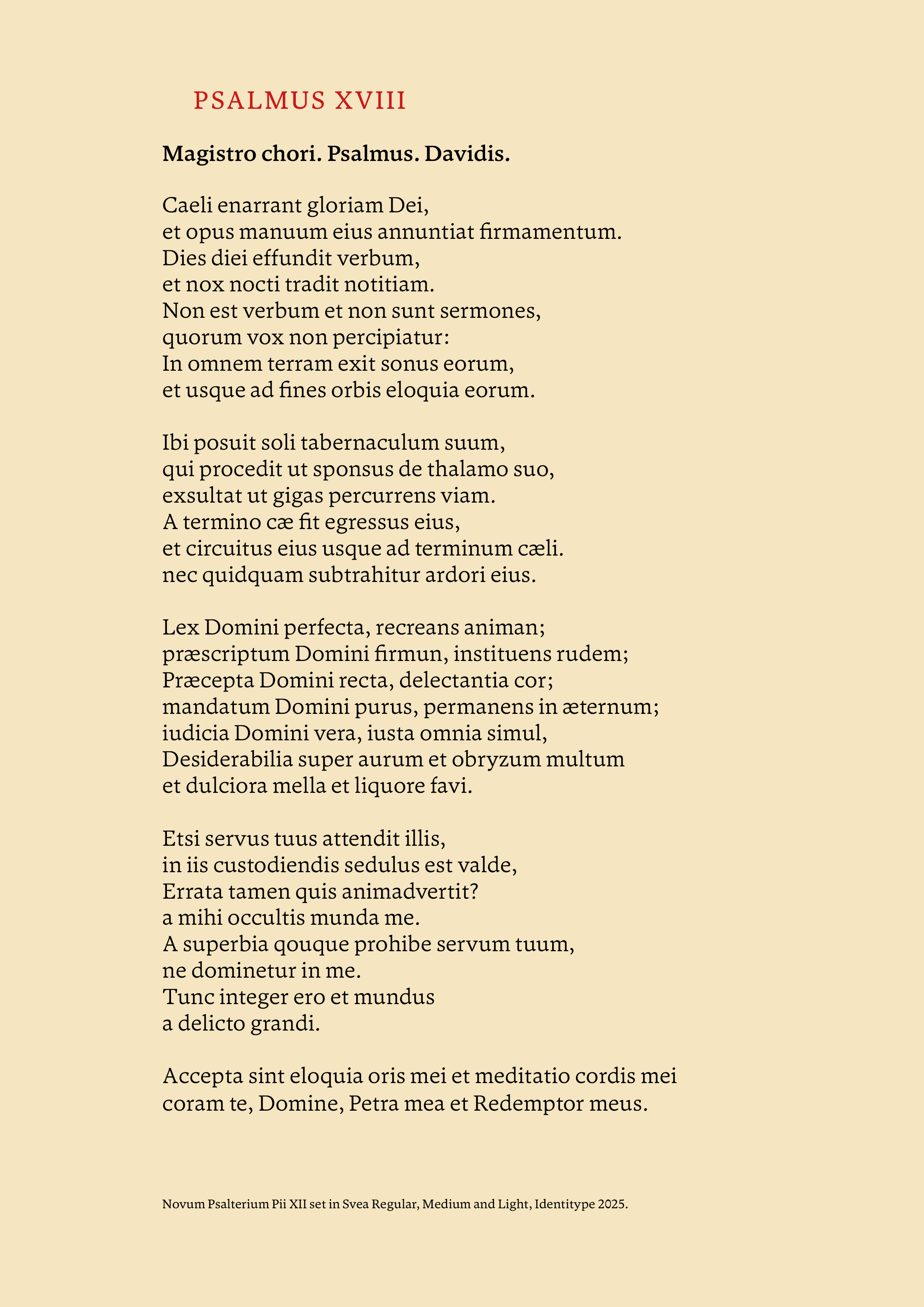License Options


Styles
About IDT Svea
Sweden is a land of contrasts, blending natural beauty, innovation, and tradition. From vast forests and shimmering lakes to Viking history and medieval architecture, it offers serenity, adventure, and progress. Central to its identity is the shield-maiden Svea, symbolizing strength, unity, and pride, inspiring values of resilience, inclusivity, and sustainability.
The IDT Svea typeface family is a contemporary design with historical roots, influenced by classic typefaces like Plantin. While drawing from the robust Renaissance-inspired forms of Plantin, IDT Svea has a distinct, modern character. With twelve styles from Book to Extra Bold, it is crafted for versatility across print, web, and digital media, combining elegance with functionality.
- Designteam
-
Örjan Nordling, Kristian Möller, and Anders Wikström (animation)
Header: Apoteus over mother Svea, Jacob Folkema 1692–1767.
- Client
-
Identitype
Opentype features
Light
Integration
Light Italic
Democracy
Regular
Inclusivity
Regular Italic
Cooperation
Medium
Modernity
Medium Italic
GreenTech
Semi Bold
Tolerance
Semi Bold Italic
Resilience
Bold
Innovation
Bold Italic
Traditions
Extra Bold
Consensus
Extra Bold Italic
Solidarity
Light
The Swedish welfare model, known as the “Nordic Model”, is a global benchmark for combining economic efficiency with social equity. Rooted in universalism, it ensures that all citizens have access to healthcare, education, childcare, and eldercare, fostering equality and social cohesion. Progressive taxation funds these services, redistributing wealth to reduce inequality and support vulnerable groups. Education is heavily subsidized, creating a skilled workforce, while universal healthcare promotes well-being for all residents. Work-life balance is central, with generous parental leave, subsidized childcare, and flexible working arrangements supporting gender equality and family life. Social security programs, including unemployment benefits and pensions, provide financial stability and empower individuals during life’s transitions. Sustainability is integrated into the model, with investments in green technology and renewable energy ensuring future generations’ welfare. Despite challenges like an aging population and integration needs, Sweden’s adaptability and commitment to equity make its welfare model an enduring inspiration worldwide.
Light Italic
The Swedish welfare model, known as the “Nordic Model”, is a global benchmark for combining economic efficiency with social equity. Rooted in universalism, it ensures that all citizens have access to healthcare, education, childcare, and eldercare, fostering equality and social cohesion. Progressive taxation funds these services, redistributing wealth to reduce inequality and support vulnerable groups. Education is heavily subsidized, creating a skilled workforce, while universal healthcare promotes well-being for all residents. Work-life balance is central, with generous parental leave, subsidized childcare, and flexible working arrangements supporting gender equality and family life. Social security programs, including unemployment benefits and pensions, provide financial stability and empower individuals during life’s transitions. Sustainability is integrated into the model, with investments in green technology and renewable energy ensuring future generations’ welfare. Despite challenges like an aging population and integration needs, Sweden’s adaptability and commitment to equity make its welfare model an enduring inspiration worldwide.
Regular
The Swedish welfare model, known as the “Nordic Model”, is a global benchmark for combining economic efficiency with social equity. Rooted in universalism, it ensures that all citizens have access to healthcare, education, childcare, and eldercare, fostering equality and social cohesion. Progressive taxation funds these services, redistributing wealth to reduce inequality and support vulnerable groups. Education is heavily subsidized, creating a skilled workforce, while universal healthcare promotes well-being for all residents. Work-life balance is central, with generous parental leave, subsidized childcare, and flexible working arrangements supporting gender equality and family life. Social security programs, including unemployment benefits and pensions, provide financial stability and empower individuals during life’s transitions. Sustainability is integrated into the model, with investments in green technology and renewable energy ensuring future generations’ welfare. Despite challenges like an aging population and integration needs, Sweden’s adaptability and commitment to equity make its welfare model an enduring inspiration worldwide.
Italic
The Swedish welfare model, known as the “Nordic Model”, is a global benchmark for combining economic efficiency with social equity. Rooted in universalism, it ensures that all citizens have access to healthcare, education, childcare, and eldercare, fostering equality and social cohesion. Progressive taxation funds these services, redistributing wealth to reduce inequality and support vulnerable groups. Education is heavily subsidized, creating a skilled workforce, while universal healthcare promotes well-being for all residents. Work-life balance is central, with generous parental leave, subsidized childcare, and flexible working arrangements supporting gender equality and family life. Social security programs, including unemployment benefits and pensions, provide financial stability and empower individuals during life’s transitions. Sustainability is integrated into the model, with investments in green technology and renewable energy ensuring future generations’ welfare. Despite challenges like an aging population and integration needs, Sweden’s adaptability and commitment to equity make its welfare model an enduring inspiration worldwide.
Medium
The Swedish welfare model, known as the “Nordic Model”, is a global benchmark for combining economic efficiency with social equity. Rooted in universalism, it ensures that all citizens have access to healthcare, education, childcare, and eldercare, fostering equality and social cohesion. Progressive taxation funds these services, redistributing wealth to reduce inequality and support vulnerable groups. Education is heavily subsidized, creating a skilled workforce, while universal healthcare promotes well-being for all residents. Work-life balance is central, with generous parental leave, subsidized childcare, and flexible working arrangements supporting gender equality and family life. Social security programs, including unemployment benefits and pensions, provide financial stability and empower individuals during life’s transitions. Sustainability is integrated into the model, with investments in green technology and renewable energy ensuring future generations’ welfare. Despite challenges like an aging population and integration needs, Sweden’s adaptability and commitment to equity make its welfare model an enduring inspiration worldwide.
Medium Italic
The Swedish welfare model, known as the “Nordic Model”, is a global benchmark for combining economic efficiency with social equity. Rooted in universalism, it ensures that all citizens have access to healthcare, education, childcare, and eldercare, fostering equality and social cohesion. Progressive taxation funds these services, redistributing wealth to reduce inequality and support vulnerable groups. Education is heavily subsidized, creating a skilled workforce, while universal healthcare promotes well-being for all residents. Work-life balance is central, with generous parental leave, subsidized childcare, and flexible working arrangements supporting gender equality and family life. Social security programs, including unemployment benefits and pensions, provide financial stability and empower individuals during life’s transitions. Sustainability is integrated into the model, with investments in green technology and renewable energy ensuring future generations’ welfare. Despite challenges like an aging population and integration needs, Sweden’s adaptability and commitment to equity make its welfare model an enduring inspiration worldwide.
Semi Bold
The Swedish welfare model, known as the “Nordic Model”, is a global benchmark for combining economic efficiency with social equity. Rooted in universalism, it ensures that all citizens have access to healthcare, education, childcare, and eldercare, fostering equality and social cohesion. Progressive taxation funds these services, redistributing wealth to reduce inequality and support vulnerable groups. Education is heavily subsidized, creating a skilled workforce, while universal healthcare promotes well-being for all residents. Work-life balance is central, with generous parental leave, subsidized childcare, and flexible working arrangements supporting gender equality and family life. Social security programs, including unemployment benefits and pensions, provide financial stability and empower individuals during life’s transitions. Sustainability is integrated into the model, with investments in green technology and renewable energy ensuring future generations’ welfare. Despite challenges like an aging population and integration needs, Sweden’s adaptability and commitment to equity make its welfare model an enduring inspiration worldwide.
Semi Bold Italic
The Swedish welfare model, known as the “Nordic Model”, is a global benchmark for combining economic efficiency with social equity. Rooted in universalism, it ensures that all citizens have access to healthcare, education, childcare, and eldercare, fostering equality and social cohesion. Progressive taxation funds these services, redistributing wealth to reduce inequality and support vulnerable groups. Education is heavily subsidized, creating a skilled workforce, while universal healthcare promotes well-being for all residents. Work-life balance is central, with generous parental leave, subsidized childcare, and flexible working arrangements supporting gender equality and family life. Social security programs, including unemployment benefits and pensions, provide financial stability and empower individuals during life’s transitions. Sustainability is integrated into the model, with investments in green technology and renewable energy ensuring future generations’ welfare. Despite challenges like an aging population and integration needs, Sweden’s adaptability and commitment to equity make its welfare model an enduring inspiration worldwide.
Bold
The Swedish welfare model, known as the “Nordic Model”, is a global benchmark for combining economic efficiency with social equity. Rooted in universalism, it ensures that all citizens have access to healthcare, education, childcare, and eldercare, fostering equality and social cohesion. Progressive taxation funds these services, redistributing wealth to reduce inequality and support vulnerable groups. Education is heavily subsidized, creating a skilled workforce, while universal healthcare promotes well-being for all residents. Work-life balance is central, with generous parental leave, subsidized childcare, and flexible working arrangements supporting gender equality and family life. Social security programs, including unemployment benefits and pensions, provide financial stability and empower individuals during life’s transitions. Sustainability is integrated into the model, with investments in green technology and renewable energy ensuring future generations’ welfare. Despite challenges like an aging population and integration needs, Sweden’s adaptability and commitment to equity make its welfare model an enduring inspiration worldwide.
Bold Italic
The Swedish welfare model, known as the “Nordic Model”, is a global benchmark for combining economic efficiency with social equity. Rooted in universalism, it ensures that all citizens have access to healthcare, education, childcare, and eldercare, fostering equality and social cohesion. Progressive taxation funds these services, redistributing wealth to reduce inequality and support vulnerable groups. Education is heavily subsidized, creating a skilled workforce, while universal healthcare promotes well-being for all residents. Work-life balance is central, with generous parental leave, subsidized childcare, and flexible working arrangements supporting gender equality and family life. Social security programs, including unemployment benefits and pensions, provide financial stability and empower individuals during life’s transitions. Sustainability is integrated into the model, with investments in green technology and renewable energy ensuring future generations’ welfare. Despite challenges like an aging population and integration needs, Sweden’s adaptability and commitment to equity make its welfare model an enduring inspiration worldwide.
Extra Bold
The Swedish welfare model, known as the “Nordic Model”, is a global benchmark for combining economic efficiency with social equity. Rooted in universalism, it ensures that all citizens have access to healthcare, education, childcare, and eldercare, fostering equality and social cohesion. Progressive taxation funds these services, redistributing wealth to reduce inequality and support vulnerable groups. Education is heavily subsidized, creating a skilled workforce, while universal healthcare promotes well-being for all residents. Work-life balance is central, with generous parental leave, subsidized childcare, and flexible working arrangements supporting gender equality and family life. Social security programs, including unemployment benefits and pensions, provide financial stability and empower individuals during life’s transitions. Sustainability is integrated into the model, with investments in green technology and renewable energy ensuring future generations’ welfare. Despite challenges like an aging population and integration needs, Sweden’s adaptability and commitment to equity make its welfare model an enduring inspiration worldwide.
Extra Bold Italic
The Swedish welfare model, known as the “Nordic Model”, is a global benchmark for combining economic efficiency with social equity. Rooted in universalism, it ensures that all citizens have access to healthcare, education, childcare, and eldercare, fostering equality and social cohesion. Progressive taxation funds these services, redistributing wealth to reduce inequality and support vulnerable groups. Education is heavily subsidized, creating a skilled workforce, while universal healthcare promotes well-being for all residents. Work-life balance is central, with generous parental leave, subsidized childcare, and flexible working arrangements supporting gender equality and family life. Social security programs, including unemployment benefits and pensions, provide financial stability and empower individuals during life’s transitions. Sustainability is integrated into the model, with investments in green technology and renewable energy ensuring future generations’ welfare. Despite challenges like an aging population and integration needs, Sweden’s adaptability and commitment to equity make its welfare model an enduring inspiration worldwide.



